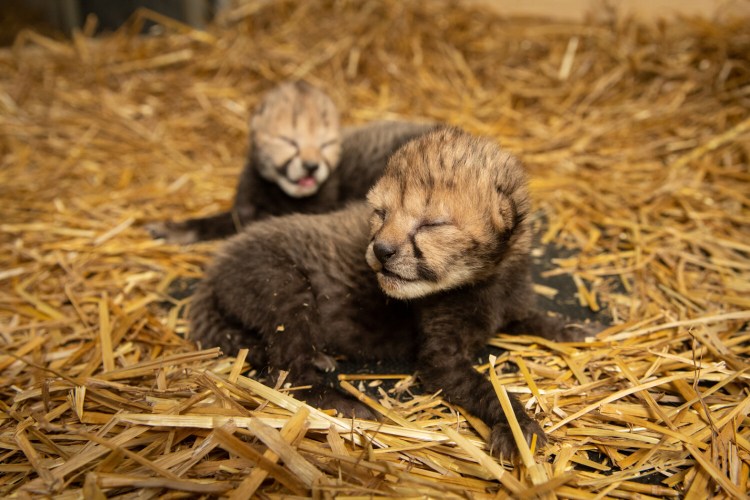For the first time, a pair of cheetah cubs was born after an in vitro fertilization procedure to a surrogate cheetah, with help from scientists at the National Zoo.
Zoo officials said the cubs were born Wednesday at the Columbus Zoo to 3-year-old Izzy. The cubs’ biological mother is 6½-year-old Kibibi.
Experts at the National Zoo in the District of Columbia said in a statement that “cheetahs naturally have low genetic diversity due to a near extinction at the end of the last ice age.” For about 20 years, scientists have been trying to boost the cheetah population through IVF and embryo transfers.
Officials said the embryo transfer was done by scientists at the Smithsonian Conservation Biology Institute in Front Royal, Virginia, and the Columbus Zoo in Ohio. The zoo waited until Monday to announce the births due to the high infant mortality rate in cheetahs – about 25 percent. The next step will be to figure out what to name the cubs.
The semen for the cheetah cubs came from a cheetah at the Fossil Rim Wildlife Center in Texas. Eggs were harvested from Kibibi at the Columbus, Ohio, Zoo in November, and they underwent in vitro fertilization in a lab.
The fertilized embryos were then transferred to Izzy.
Officials said it was the third time scientists had attempted the procedure worldwide and it was the first time it worked.
Pierre Comizzoli, a reproductive biologist at the Smithsonian Conservation Biology Institute and one of the scientists who performed the embryo transfer, said the birth makes cheetahs the second large cat to successfully be born from in vitro fertilization. The first was the tiger in 1990.
“The cheetah is one new success in terms of IVF but this is still extremely rare in wild species,” he said. “Wild species are far behind livestock and humans.”
Kibibi has never given birth but was unlikely to reproduce on her own. “Her valuable genes were at risk of never being passed on,” the zoo said in a statement.
Meanwhile, Izzy is “less genetically valuable,” and scientists had recommended she not be bred. Izzy was hand-raised as a cub and comfortable with keepers, making her a good candidate for surrogacy, officials said.
About a month after the procedure, veterinarians discovered two fetuses on an ultrasound. For cheetahs, pregnancies usually last between 90 and 96 days.
Izzy started showing signs of labor on Feb. 19. The cubs – a male and a female – have been nursing since they were born.
Adrienne Crosier, a cheetah biologist at the Smithsonian’s Conservation Biology Institute, said artificial insemination has been performed on cheetahs for decades, but a cub hasn’t been born as a result for about 20 years.
“Just the fact that we were successful with embryo transfer after only the third attempt gives me hope for the future of this technique for improving cheetah management, potentially on a global scale,” she said in a statement. “We can extend a cheetah’s biological clock.”
Crosier said the public might be able to see the cubs this spring at the Columbus Zoo. They join 17 other cheetahs at the zoo.
In the wild, cheetahs have become extinct in at least 13 countries in Africa. There are about 7,500 cheetahs in the wild. They are listed as vulnerable by the International Union for Conservation of Nature.
Copy the Story LinkComments are not available on this story.
Send questions/comments to the editors.


